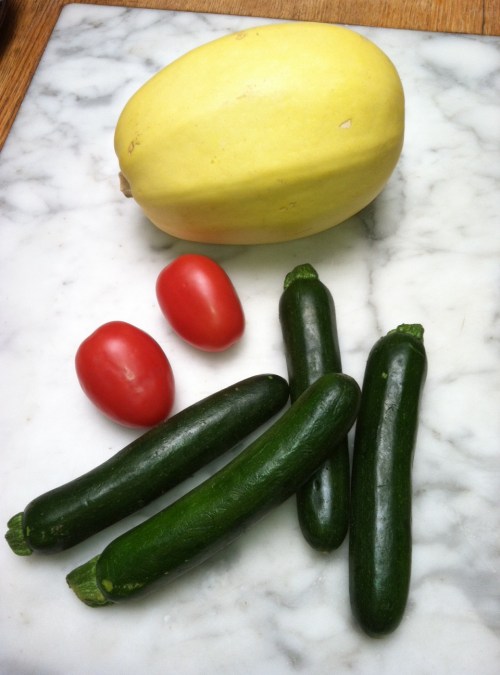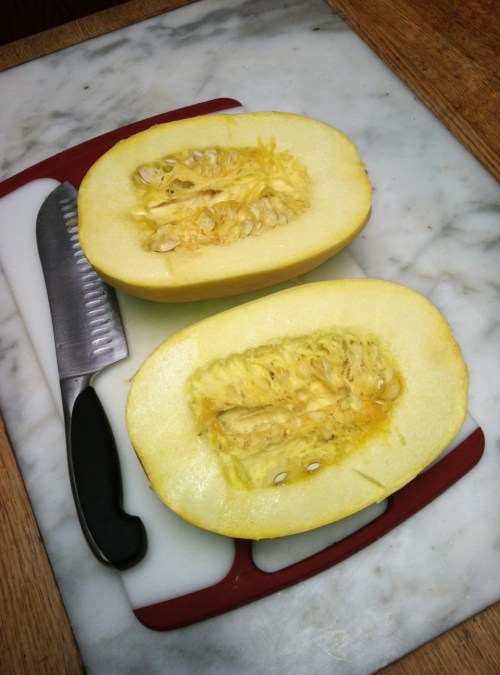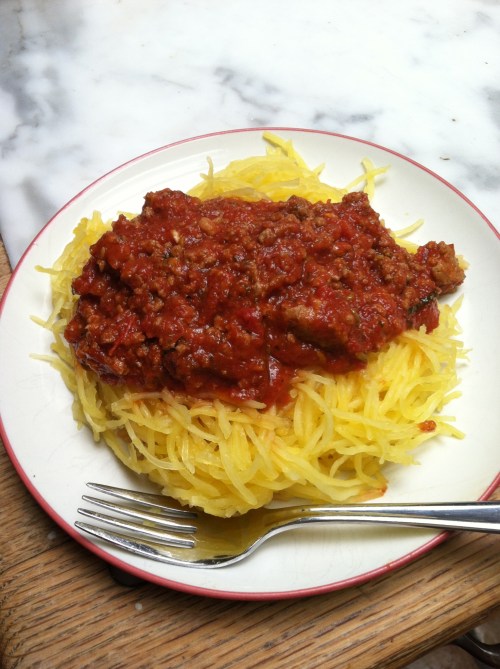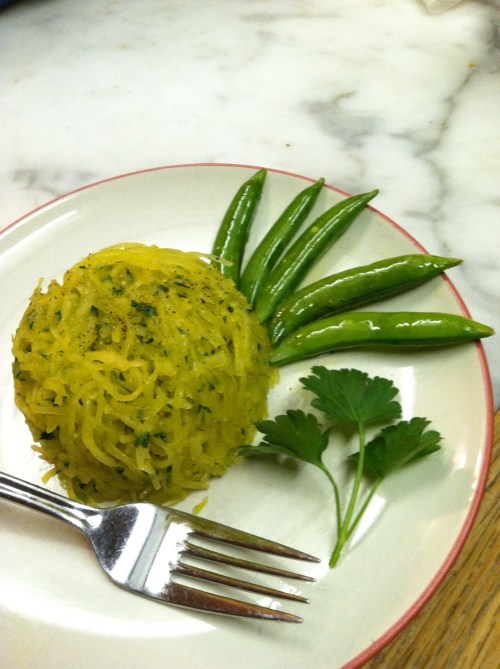It’s hard to give up pasta. Many diabetics who don’t notice that their blood sugar levels spike too high when they eat pasta. What’s too high? In general, I’d say over 150 mg/dl (8.33 mmol/l) measured one hour after a meal, or over 130 mg/dl (7.22 mmol/l) two hours after the meal.
Other experts disagree and propose other numbers.
An alternative to spaghetti pasta that shouldn’t raise blood glucose levels as high is spaghetti squash. It’s all about the carbohydrates. A cup of cooked spaghetti squash has 10 g of carb; a cup of cooked spaghetti has 43 g. The fiber grams are about the same. Numbers are from FitDay.com.
Spaghetti squash is a classic low-carb vegetable. If you’ve never tried it, you should. As vegetables go, it’s one of the largest, heaviest, and most interesting to prepare. Easy, too. The spaghetti squash season is autumn and winter in the northern hemisphere. Purchasing in spring and summer may be iffy.
In my part of the world, supermarket spaghetti squashes weigh between two and five pounds. We cooked a three-pounder (1.4 kg) that yielded five cups; a five-pounder (2.3 kg) gave us 12 cups. A serving size is one, maybe two cups. What you don’t eat immediately stays fresh in the refrigerator for at least several days. Re-heat by microwaving or stir-frying.
Like pasta and potatoes, the squash by itself is bland. It’s a great substrate for sauces or seasonings.
Here’s how we cook it at the Parker Compound. Preheat the oven to 375º F 0r 190º C. Very carefully slice the squash in half lengthwise. Spoon out and discard the guts (seeds and membranes like a pumpkin; it even smells like a pumpkin). Put the halves flat-side down in a pan, then add a half inch (1.3 cm) of water to the pan. Cover with foil and bake until the outer shell (rind) is fairly easily pierced with a paring knife. This will be about 45 minutes for a two-pound squash (0.9 kg); 90 minutes for a four-plus pounder (2.3+ kg). Then turn them over, re-cover with foil, and cook 15 minutes more, until very tender. Remove from the oven and allow them to cool for a few minutes. Then use a fork to pull the strands away from the rind.
Other cooks simplify the process and just place the squash halves flat-side down on a baking sheet and cook for 30-60 minutes. Some leave the seeds in while cooking and spoon them out just before the stranding step.
Now what?
You got options.
Our first experiment was with l0w-carb spaghetti sauce.
Next we took three cups squash (710 ml) and mixed in 2 tbsp (30 ml) extra virgin olive oil, 2.5 tbsp (37 ml) chopped parsley, 1/2 tsp (2.5 ml) minced fresh garlic, 1/2 tsp (2.5 ml) salt, and 1/8 tsp (0.6 ml) black pepper.
Finally, we took a cup (240 ml) of the squash and added minced celery (4 inches or 10 cm of stalk), 3 minced black olives, 5/8 oz (18 g) of minced sweet (bell) pepper, 1/2 clove of minced garlic, salt (a dash), and pepper to taste.
These last two options I consider side dishes. By the way, they taste good either cold or warm. They would go well with a number of entrees, such as steak or salmon.
I’ve read that this squash is good with pesto, or just with salt and (non-paleo) butter.
Nutrition facts from FitDay.com:
One cup of cooked spaghetti squash has 75 calories (I’ve seen 42 elsewhere), 10 g of carbohydrate, 2 g of fiber, 8 g of digestible carb, 4 g of fat (predominantly MUFA), minimal protein, and a fair amount of vitamins A, niacin, B6, and C. Plus 8% of your RDA for manganese.










Great recipes, Steve. If you’re pressed for time, microwave the whole squash for 3-5 minutes to soften. Cut in half, remove seeds. Place cut side down in a shallow baking dish with half a cup of water. Microwave 5-10 minutes longer until fork tender. Scrape strands and continue as above.
Thank you, Michelle!
How did you get it to look so regular and similar? I would have thought that after cooking it it would be difficult to get a ‘clean cut’.
That’s the beauty of spaghetti squash, Hemming. It forms strands like that naturally. No human talent required.
Ah, thanks. I didn’t realise it was that easy 🙂
I love spaghetti squash, and I love being able to sub it for pasta. Thank you for these ideas.
Not sure if you meant to do this, but it looks like you used nutrition facts from Fitday for spaghetti squash with added fat: http://tinyurl.com/lnp74ry
Otherwise, Fitday lists two cups of plain spaghetti squash as having 80 calories in this article (http://tinyurl.com/kn4m64t), which is more in line with other nutrition-fact resources.
Hi, Judy. I think we found an error in Fitday’s database. I rechecked the entry for cooked spaghetti squash and come up with my original numbers. Here’s a link but it may no work since I used my password to get in: http://www.fitday.com/fitness/FoodView.html?_s_FoodKey=s-fndds2-f75233200 or http://www.fitday.com/fitness/FoodView.html?_s_FoodKey=s-fndds2-f75233200&RenderType=PrintI checked your link and see what you mean. I saw where you got your numbers, too. They can’t both be right.
The first free online nutrition database I ever saw was at NutritionData.com; I don’t think it’s been updated for over five years. Both databases probably depend on the USDA’s Nutrient Database, which I’ll check when time allows. I bet it says about 40 cals/cup.
-Steve
The USDA Nutrient database says 42 cals/cup.
Pingback: Recipe: Low-Carb Spaghetti Sauce | Paleo Diabetic
Pingback: Paleobetic Recipe: Spaghetti Squash Spaghetti | Paleo Diabetic
I see this spaghetti squash all the time but have never tried it. Looks good.
Hi Steve,
As you suspected might happen, your links didn’t work. Did they take you to the same cooked S. squash in the first link I provided? That entry has the same numbers that you posted, but It says in the heading that fat was added. It was the 4 grams of fat that jumped out at me from your post because like most vegetables, spaghetti squash has minimal fat unless it’s added.
Anyway, I picked up a s. squash today because your recipes looked so delicious…simple and inspiring.
Judy
Okay, now I see what you are talking about, Steve. When I logged into Fitday (which I didn’t do before), there are two entries for cooked s. squash containing 75 calories, and one of those says fat added in cooking. You’re right; there’s an error in their database.
Judy
Thanks for getting back with me. I’d rather see FitDay make a mistake than me. “Doctors bury their mistakes.”